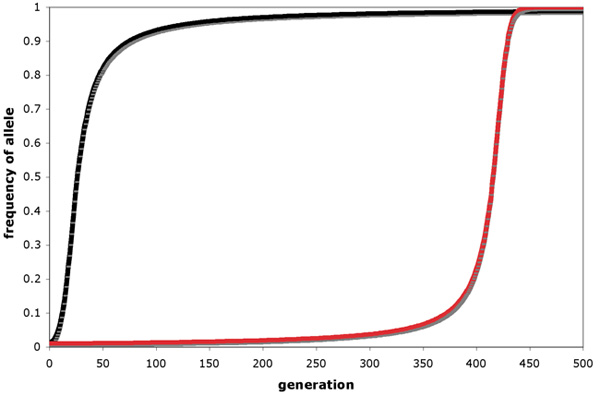Recessive allele.
What is an allele that produce its characteristic phenotype only when it is paired with identical allele. (i.e., in homozygous state)
Genetic bottleneck.
What is an event in which the number of individuals in a population is reduced drastically, leading to lasting effects on the genetic variation of a population?
They are the processes that ensure you are genetically different from your full sibling.
What are independent assortment and recombination?

What effect does each type of selection have on the mean and variance of the trait in the next generation? 1.Mean changes in direction of selection; variance reduced 2.Mean stays the same; variance reduced 3.Mean stays the same; variance increased
What is directional, stabilizing, disruptive selection?
______ are not heritable mutations in animals.
What are somatic mutations?
Coalescence.
What is the process by which looking back through time, the genealogy of any pair of homologous alleles merges in a common ancestor?
_____ is one of the most probable reasons that lead to an increase in homozygosity in populations.
What is inbreeding?
_______ acts to loci that are inherited together more commonly than expected, leading to a violation of independent assortment.
What is genetic linkage?
Light colored oysters blend in with the sand in the shallow water and dark colored oysters blend into the shadows in dark water. Medium colored oysters show up against both backgrounds and thus are more exposed to predators in either environment. This is an example of __________.
What is disruptive selection?
1. Is how the gene is evolving if dN/dS = 1
2. Is how the gene is evolving if dN/dS > 1
What are neutral selection and positive selection?
This is the allele frequency formula at Hardy-Weinberg equilibrium.
What is 1=p^2+2pq+q^2?
When a mutation in a single gene affects many phenotypic traits.
What is pleiotropy?
These distinctive areas within chromosomes are driving the formation, and defining the boundaries, of LD blocks.
What are recombination hotspots?
 Under directional selection, the two curves represent _______ and ______.
Under directional selection, the two curves represent _______ and ______.
What are a dominant and a recessive allele?
The allele is at high frequency and linkage disequilibrium with surrounding loci is high.
What is the evidence that an allele has experienced a selective sweep in the recent past?
Given two diploid subpopulations in H-W equilibrium, with identical allele frequencies, the combined population will contain fewer heterozygotes than expected, due to ________.
What is the Wahlund effect?
Decreases divergence between populations and can limit adaptation in some populations.
What is gene flow?
What is association mapping?
Pupa within gall:

The type of selection you would expect to affect gall size, if a population of gall flies occurred in an area where birds (predators) were present but parasitoid wasps (parasitoids) were absent.
What is directional selection?
The synonymous substitution rate is often assumed to represent it.
What is the rate of evolution by genetic drift?
Under migration, this measure of population subdivision is inversely proportional to the population size and migration rate.
What is the fixation index (FST)?
The 2 main findings on molecular phylogenetic studies of large human populations.
What are: - most human genetic diversity is found in Africa - Non Africans form a monophyletic group ?
This measure of linkage is inversely proportional in an exponential manner with the recombination rate "c" between two loci.
What is the LD coefficient "D"?
A lethal recessive allele "a" is maintained at a constant frequency in a population via mutation, having achieved ________.
What is mutation-selection balance?
The splicing-affected gene region that I would choose if I am studying the relationships among a group of 10 cichlid fishes that have speciated very recently (say the last 5,000 years). (Explain your answer.)
What is an intron?